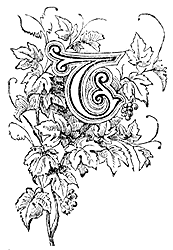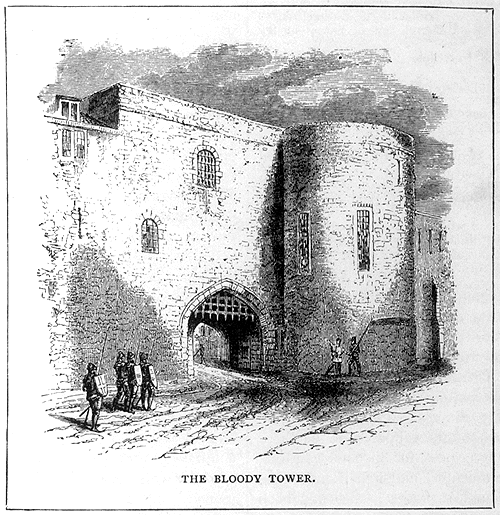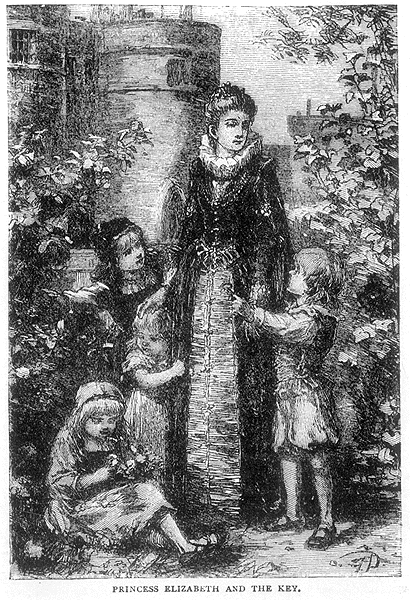 |

HE Tower of London - at once a palace, a fortress, and a prison -
is most closely associated with the events English history. When we
say a palace, we must add, that of the palace of the Tudors that
existed within those walls as a splendid building, with a painted
hall, spacious galleries and noble courts, not a vestige now remains.
Its place has been taken by the Ordnance Offices. The Tower itself
has remained as we see it, though the dwelling-place of kings within
its walls is gone.
Yet how grand that painted hall must have been! Here King John of
France was feasted by King Edward III. Here Henry of Lancaster wore
the crown torn from Richard II.'s brow, and Henry VIII. banqueted
with his queens, two of whom were destined to die in that fatal
fortress.
The Tower is always a weird place, by night especially. The writer
spent many days and nights, during childhood, as a guest there, and
has often walked in the solemn moonlight round it, on the platform
under the old trees, passing the Devil's Battery, the Stone Battery,
and the Wooden Battery, and again the White Tower, all clothed in the
solemn light - awesome, and full of terrible memories; for the past
scenes of three or four hundred years seemed to be absolutely'
present under the charm of the hour, and one could almost see the
victims of the savage Yorkists and Tudors passing in shadowy
procession before one. The boy princes; the unhappy Anne Boleyn
clasping her little throat; the saintly Jane Grey; the gallant
Raleigh.
Gray has apostrophised the Tower thus:
and Shakspeare asserts the same origin of the Tower in the scene
where young Edward V. objects to the Tower as his residence.
But in fact Julius Caesar did not build the Tower. It was built by
Gundulf, Bishop of Rochester (who also erected Rochester Castle), in
1078, for William the Conqueror. Rufus added to the keep, Henry I.
strengthened it, and Stephen kept his court here.
It is a singular fact that Ralph Flambard, Bishop of Durham, who
assisted in completing the Tower, was the first person imprisoned in
it. He managed, however, to escape. His friends conveyed a rope to
him in a flagon; he made his keepers tipsy (therefore doubtless wine
had been sent with the flagon), and then, when they were so
intoxicated as to be blind and incapable, he let himself down from a
window in the south gallery, taking his pastoral staff with him. The
rope broke, and the bishop had a serious fall; but though he was
injured by it, he managed to escape to Normandy, and lived to recover
his See.
King John held his court here; Edward II. found refuge in the
fortress; and here were imprisoned two monarchs - David, king of
Scotland, and John, king of France, the captives of our third Edward.
Richard II. found safety in the Tower from, Jack Cade and his rebels,
and was imprisoned here when first brought to London by usurping
Bolingbroke.
Here his grandson, the saintly Henry VI., expiated his grandsire's
crime by his death, - murdered, it is said, by Gloucester.
In a strangely small and dark room in the Bloody Tower the two
young princes of York are said to have been murdered.
The room is not generally shown, as the tower is inhabited; but we
have seen it, and no spot could have been better adapted for a foul
midnight murder. A passage runs between it and the wall of the tower,
and the light in it is borrowed from the loophole or window, the side
of the room towards the passage being glazed half-way from the top.
Through this window tradition says that Tyrrel watched the ruffians
execute their deed of blood. The bed is placed sideways to the
window.
We cannot resist giving Shakspeare's account of this sad tragedy.
Grave doubts have at
different times existed as to the death of at least one of the
princes - York; but upon the whole the evidence is strongly in favour
of the tradition. In Charles lI.'s reign a box was found at the
bottom of the staircase which leads to the chapel of the White Tower.
It contained bones, supposed to be those of the young princes, for
Sir Thomas More, who wrote a century and a half before the box was
found, says the bodies had been removed from the Bloody Tower by a
priest, at the king's request, and buried elsewhere; but both king
and priest dying suddenly, the place of their burial remained a
secret, and when Henry VII. would have given anything to exhibit
them, in order to disprove Warbeck's claims, he could not find them.
Charles II. caused the skeletons of the boy princes to be removed to
Henry the Seventh's Chapel, where a Latin inscription upon marble
records the discovery, after a lapse of a hundred and ninety-one
years, of these remains of Edward V. and the Duke of York, who were
confined in the Tower, put to death, and secretly and ignominiously
buried by Richard III.
A singular discovery was made in this Tower in
1868.
 An opinion had long been entertained that a staircase existed
between the Bloody Tower and the Wakefield Tower, and at the period
mentioned an investigation of them led to the discovery that in the
thickness of the walls connecting the Bloody and Wakefield Towers
there is a small passage which leads past the chamber containing the
windlass for raising the portcullis, and ascends in a spiral course
to the top of the ballium wall; thence it leads into a passage which
connected the Bloody Tower with the Lieutenant's lodgings, and
communicated immediately with the room in which the princes are
traditionally said to have been murdered. At the bottom of the
staircase, the stones of which are sharp and clean, was a small cell, with a chimney 'due, which (both cell and flue) were crammed with
bones and earth. The bones were at first said to be human, as might
be expected; but upon careful examination, they were found to be
entirely the bones of animals, principally deer and oxen. It has been conjectured that the staircase may have been closed immediately after the murder; that the bodies were concealed in the flue, so closely adjoining, in order to escape the notice that their removal and
burial elsewhere would occasion, and that both flue and stairs were
at once closed up by Richard's own orders. The work is carefully
executed, the openings being closed with stone so as exactly to match the walls and thus escape observation, as it did so many years "At
all events, it is very singular," says Mr. Timbs, "that a convenient staircase, already made, should be closed, thereby necessitating the formation of another on the farther side of the tower to reach the chambers above."
In front of the foot of the stairs is an arched opening, which has all the appearance of a doorway, but it is at a consider. able height from the ground.
The Bloody Tower gateway opposite the Traitor's Gate is the main entrance to the inner ward. It has massive gates and a portcullis, said to be the only one in England now fit for use.
The Traitor's Gate was a small postern with a drawbridge, which was seldom let down but for the passage of some distinguished prisoners.

By this gate the unhappy
Anne Boleyn entered the Tower in hysterical agony; and her daughter,
the dauntless Elizabeth, stepping boldly from the boat that bore her
to prison and possible death, declared her spotless loyalty. She was
confined in the Bell Tower with great severity. Mary's counsellors do
not seem to have intended to let her live, but the murmurs of the
Londoners and the threats of Lord Howard and his fleet compelled the
Queen to show some courtesy to the royal prisoner, on whom Mass had
been forced and who had not been suffered to take outdoor exercise in
the Queen's garden. When at last this privilege was accorded her, she
found amusement and consolation in the children who lived in the
fortress. A boy of four years old took a great fancy to her, and
carried her flowers whenever he could get them. This infant was
actually brought up before the council and strictly examined, with
promises of figs and apples, if he would tell who had sent him to the
Princess. He said, "I will go to the Earl of Devonshire, and
ask what he will give me to carry to her." The Chancellor
exclaimed, "This same is a crafty child." "Ay, my
Lord," said the little boy, who evidently did not under stand
the word "crafty," "but pray give me the figs."
"No," said the Chancellor. "Marry, you shall be
whipped if you come any more to the Lady Elizabeth."
It is
pleasant to think of the royal Elizabeth's captivity being cheered by
the innocent love of children. When walking in the garden, the little
ones gathered round her; and tradition says they found a little key,
and offered it to her, hoping that she might escape by means of it,
but begging her to return sometimes to see them, for they loved her.
Sir Walter Raleigh was thrice imprisoned in the Tower. For twelve
long years in the Bloody Tower, where Prince Henry, the son of James,
visited him, and was heard say that no being save his father would
keep such a bird in a cage. The great seaman and historian wrote his
"History of the World" in the Tower. It is one of the great
prison books, among which we may also name "Don Quixote"
and the "Pilgrim's Progress."
Raleigh never left the Tower
after his third incarceration till he went to the scaffold; given up
by the cowardice of James I. to the vengeance of Spain.
The walls of
the Beauchamp Tower are rich in inscriptions left by the prisoners
kept in it In one of the state prison rooms are cut the
letters, -JANE, JANE, supposed to have been done by Lord
Guildford Dudley during his imprisonment and separation from his
wife, who was at the same time a prisoner.
Amidst all the horrid
memories of the Tower there is one amusing story. It dates from the
time of the conflict between the Red and White Roses.
Sir Henry Wyat
was a Lancastrian, and in the reign of Richard III. found himself a
prisoner in the royal fortress. He was in a cold narrow cell, "where," the Wyat Papers say, "he had neither bed to lie on,
nor clothes to warm him, nor meat for his mouth. He had starved there
had not God, who sent a crow to feed His prophet, sent this and his
country's martyr a cat, both to warm and feed him. It was his own
relation unto them from whom I had it. A cat came one day down into
the dungeon unto him, and, as it were, offered herself unto him. He
was glad of her, laid her in his bosom to warm him, and by making
much of her won her love. After this she would come every day unto
him, divers times, and, when she could get one, bring him a pigeon.
He complained to his keeper of the cold and his short fare. The
answer was, 'he durst not better it.' 'But,' said Sir Henry, 'if I
can provide any food, will you promise to dress it for me?' 'I may,
well enough,' said the keeper; 'you are safe for that matter,' and
being urged again, promised him, and kept his promise, for he
actually dressed for him such pigeons as his caterer the cat
provided."
Sir Henry was released and restored to his estates by
Henry VII., and had a portrait of himself and of his friend, the cat,
painted, with a pigeon in its paws, offering it through the grated
window of his dungeon to the captive.
The poets Surrey, Wyat, and
Raleigh were preceded in their captivity in the Tower by one of the
earliest of the French poets, Charles, Duke of Orleans, taken
prisoner at Agincourt, and brought to England by Henry V. He spent
twenty five years in captivity; partly in the Tower, partly at
Pontefract; but many of his poems were written in the Tower, an
admirable view of which adorns one of his MS. The Duke of Orleans was
one of the best of the early French poets, and of excellent moral
character. He was left for dead on the field of Agincourt; but Henry
V. ordered all care to be taken of him, and he was conducted to
Calais with the other prisoners. He refused on the road to take any
nourishment, and Henry remonstrated with him, saying, " Fair
cousin, be of good cheer; it is to the protection of Heaven that my
victory alone is due. Heaven was determined to punish the French
nation for their bad conduct." And Charles, whose father had
been basely murdered in Paris, could scarcely fail to acknowledge the
truth of the conqueror's words. Whilst he was a captive his wife
died. We will give some of his poems (translated by Miss Costello)
which were probably written in the Tower.
The writer of these touching lines was at length
ransomed for an immense sum by Philip the Good, Duke of Burgundy, and
after his release married the Princess Marie of Cleves, Philip's
niece. She became the mother of a son, who succeeded to the throne of
France as Louis X l., and married Mary Tudor, the sister of Henry
VIII.
The Armouries in the Tower are worth careful notice. Here we
have defensive and offensive armour and arms from the time of the
Crusades. Gambuised armour was made of stitched padded work, the
shirt of mail was formed of rings, or of small metal plates, covering
each other like the scales of a fish Over the armour surcoats were
worn, to prevent the sun heating the metal. Armour was at times so
expensive that it was said of Sir Walter Raleigh, who had a suit of
silver armour, that "he bore a Spanish galleon on his back."
There are terrible instruments of torture also in the Tower, some of
which are said to have been brought over in the Spanish Armada. There
are thumbscrews, one of which William III. insisted on trying on
himself, but declared, when it was screwed to the uttermost, that he
would have agreed to anything rather than bear such agony. There are
also yokes, cravats, and a collar of torment. We do not know if a
rack still remains. Another kind of torture in the Tower is a cell
called "Little Ease." It is so small that the prisoner in
it could neither stand, sit, nor lie at full length. He was compelled
to draw himself up in a squatting position, and remain thus day and
night.
The Crown Jewels are also kept in the Tower. Their attempted
robbery by Colonel Blood is one of the mysteries of Charles II.'s
disgraceful reign. Our Queen has added to them the famous Koh-i-noor,
- a gift to her from her army. It is said to be the finest
diamond in the world.
It may interest our readers to glance at a plan
of the Tower, which will explain how it was that it contained a
palace, and was also a prison and a fortress. A clear notion of its
extent may be gathered from the above, which was engraved from a
survey made in 1597. Very few changes have taken place since.
|
 |